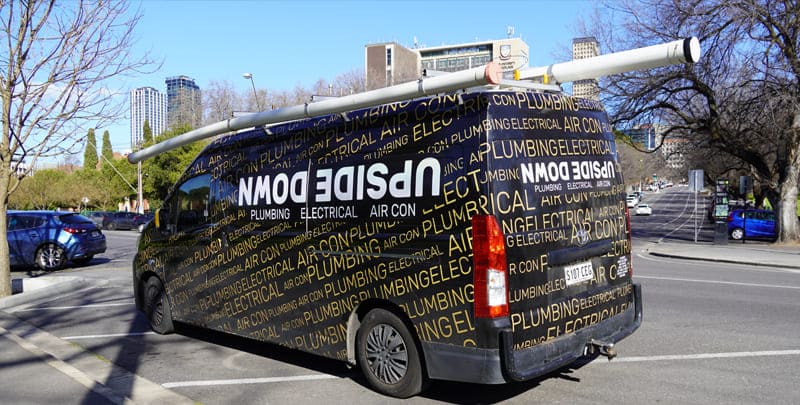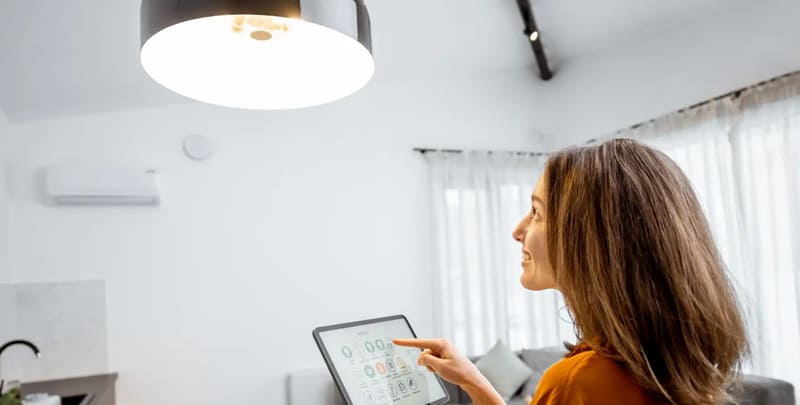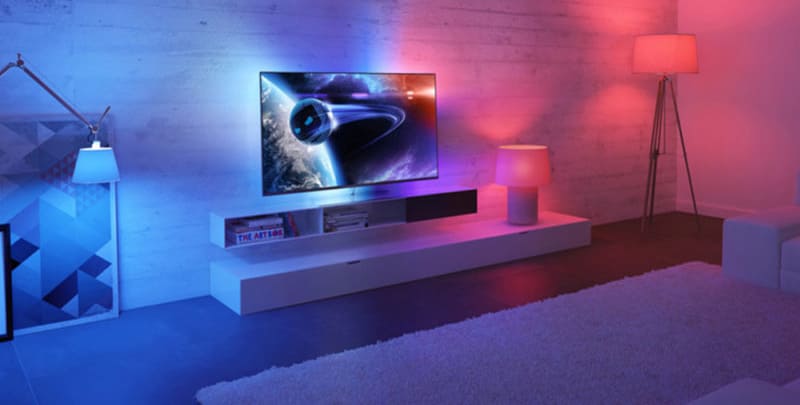How Does Smart Lighting Work?

In the ever-evolving home automation landscape, smart lighting has emerged as a leading innovation, revolutionising how we interact with and control our living spaces.
From smart light bulbs to advanced lighting systems, here’s a guide to all you need to know about smart lighting. This technology has transformed our homes into more efficient, convenient, and energy-conscious environments.
Delve into the intricate workings of smart lighting, exploring its various components, benefits, and the technology that makes it all possible.
Understanding Smart Lighting
At its core, smart lighting is an intelligent lighting system that allows users to control the illumination of their spaces through smart bulbs, smart lights, and other interconnected devices.
Unlike traditional lighting setups, which rely on manual switches, smart lighting introduces a new level of automation and customisation.
Through the integration of cutting-edge technology, smart lighting systems enable users to adjust brightness, colour temperature, and even the ambience of a room according to their preferences.
The Functionality of Smart Lighting
Smart light bulbs are the cornerstone of smart lighting setups. These smart light bulbs require advanced technologies such as light-emitting diodes (LEDs) to illuminate. However, what sets them apart is their connectivity to various platforms and devices.
This connectivity allows users to control the bulbs remotely, whether through dedicated smartphone apps, voice assistants like Amazon Alexa or Google Assistant, or even smart speakers.
Behind the Scenes: How Smart Lighting Works
The magic of smart lighting lies in its integration of multiple components. The smart bulb is at the heart of the system equipped with wireless communication capabilities. These bulbs connect to a central hub, often using protocols like Z-Wave or Zigbee, which act as intermediaries between the bulbs and other devices, like your smartphone or voice assistant.
The command is transmitted to the central hub through a mobile app, voice command, or scheduled automation when you interact with a smart lighting system.
This hub then communicates with the corresponding smart bulbs, conveying the desired changes in brightness, colour or other settings. This seamless and rapid communication network allows real-time adjustments and effortless control of your lighting environment.

Advantages of Smart Lighting
The many benefits of using smart lighting go beyond the ease of using voice commands. Other advantages include:
- Energy efficiency and cost savings: One of the most significant advantages of smart lighting is its contribution to lower energy consumption and subsequent cost savings. Users can ensure that lights are only on when needed through features like dimming capabilities and the ability to set timers. Additionally, some smart bulbs offer motion sensor-based functionality, automatically turning off when no movement is detected, further conserving energy.
- Personalisation and mood enhancement: Gone are the days of a one-size-fits-all lighting solution. With smart lighting, you can tailor the illumination of each room to suit different moods and occasions. Adjusting the colour temperature and brightness allows you to create various atmospheres, from warm and cosy to bright and vibrant, all at the touch of a button or a simple voice command.
- Seamless integration with smart homes: Smart lighting doesn’t operate in isolation; it’s part of a broader ecosystem of smart home technology. This integration means you can synchronise your lighting with other devices and actions in your home. For instance, you can program your lights to dim when you start a movie on your home theatre system or turn them off automatically when you leave the house. This interconnectedness enhances the overall convenience and efficiency of your living space.
From Smart Bulbs to Full Systems
The use of smart lights can start with simply using a smart bulb and progress to having your entire lighting system controlled by a central hub.
The Role of Smart Bulbs
Smart light bulbs are the building blocks of any smart lighting setup. They come in various shapes, sizes, and features, making it easy to find the perfect fit for your needs.
Some smart bulbs can change colours, while others focus on different shades of white light, from warm to cool. These bulbs are also known for their extended lifespan and durability compared to traditional incandescent bulbs.
The Power of Centralised Control
Smart lighting systems often employ a central hub as a control centre for all connected devices. This hub facilitates communication between your home’s smart bulbs, smartphone, voice assistants, and other smart devices.
The centralised control simplifies the user experience and ensures all your lights are interconnected seamlessly, providing a cohesive lighting environment.
Voice Commands and Beyond
One of the most impressive features of smart lighting is its compatibility with voice assistants like Amazon Alexa, Google Assistant, and Apple HomeKit.
This integration lets you control your lights using simple voice commands, making the entire experience hands-free and incredibly intuitive. Whether you’re in bed and want to turn off all the lights or enter a room and need to adjust the brightness, your voice assistant is at your service.
The Future of Illumination: Constant Innovation
Smart lighting is dynamic, marked by continuous innovation and new possibilities. With the rapid advancement of smart home tech, we can expect even more seamless integration, enhanced energy efficiency, and greater personalisation in the years to come.
From controlling entire lighting systems using a single app to syncing lights with your home’s security system, the future of smart lighting holds limitless potential.
Finding Local Electrical Experts
How do you set up a smart lighting system? The first step is finding local electrical specialists who know and understand the technology. Let’s take a look at who and what to look for.
1. Expertise in Smart Plug Installation
When it comes to integrating smart plugs into your lighting system, it’s crucial to have local electrical experts who understand the intricacies of these devices.
Look for professionals who are well-versed in configuring and installing smart plugs seamlessly. They should be capable of ensuring a secure connection and proper synchronisation with your existing smart lighting setup.
2. Specialists in Smart LED Bulbs
Smart LED bulbs offer a world of possibilities for lighting customisation. However, their installation requires a certain level of technical expertise.
Opt for local electrical experts who have experience with smart LED bulbs. They should know how to program and calibrate the bulbs according to your preferences, creating the desired ambience and energy-efficient lighting.
3. Mastery of Wall Switch Integration
Installing wall switches in a smart lighting system demands precision and a comprehensive understanding of wiring and connectivity. Seek out electrical experts who have successfully integrated various types of wall switches into diverse home environments.
They should be able to configure the switches to work harmoniously with other components of your smart lighting setup.

4. Experience in Troubleshooting and Repairs
Even the most advanced smart lighting systems might encounter glitches or require repairs over time. Choose local electrical experts who are well-equipped to diagnose and resolve issues promptly.
A deep understanding of the technologies behind smart plugs, smart LED bulbs, and wall switches is essential for efficient troubleshooting and effective repairs.
5. Personalised Solutions and Recommendations
Local electrical experts who are experienced in the realm of smart lighting can offer tailored solutions and recommendations.
They can assess your space, preferences, and electrical setup to advise on the most suitable products and configurations. This ensures your smart lighting system is functional and tailored to your needs.
6. Commitment to Safety and Compliance
The installation and integration of smart lighting components must adhere to safety standards and local regulations. Look for electrical experts who prioritise safety and compliance in their work.
They should know the proper installation practices, grounding requirements, and other safety measures associated with smart plugs, LED bulbs, and wall switches.
7. Proven Track Record and Positive Reviews
Consider their track record and reputation when selecting local electrical experts for your smart lighting needs. Online reviews and recommendations from past clients can provide insights into the quality of their work.
Look for professionals with a history of successful installations, repairs, and satisfied customers in smart lighting.
You can ensure a seamless, safe, and optimally functioning smart lighting system by partnering with local electrical experts with expertise in smart plugs, smart LED bulbs, and wall switches.
Their knowledge and experience will enhance your lighting experience and contribute to the longevity and efficiency of your smart home setup.
Light Up Your World
In a world where innovation illuminates the way forward, smart lighting stands at the forefront. Experience the convenience, energy efficiency, and seamless control of your home environment with the power of smart light bulbs, smart light switches, and advanced smart switch technology.
From effortless remote control to a harmonious synergy with other smart devices, smart lighting transforms your space into a realm of brilliance and modernity. Say goodbye to the limitations of regular light bulbs and embrace a brighter, smarter tomorrow.
Please note: This information is provided for advice purposes only. Regulations differ from state to state, so please consult your local authorities or an industry professional before proceeding with any work. See our Terms & Conditions here.